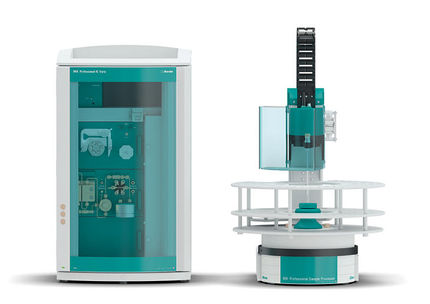To use all functions of this page, please activate cookies in your browser.
my.chemeurope.com
With an accout for my.chemeurope.com you can always see everything at a glance – and you can configure your own website and individual newsletter.
- My watch list
- My saved searches
- My saved topics
- My newsletter
Thallium
Thallium (pronounced /ˈθæliəm/) is a chemical element with the symbol Tl and atomic number 81.[1] This soft gray malleable poor metal resembles tin but discolors when exposed to air. Thallium is highly toxic and is used in rat poisons and insecticides but since it might also cause cancer (although the United States EPA does not class it as carcinogen), this use has been cut back or eliminated in many countries. It is also used in infrared detectors.[2] It has even been used in some murders, earning the nicknames "The Poisoner's Poison" and "Inheritance powder" (alongside arsenic). Product highlight
Notable characteristics
This metal is very soft and malleable and can be cut with a knife. When it is first exposed to air, thallium has a metallic luster but quickly tarnishes with a bluish-gray tinge that resembles lead (it is preserved by keeping it under oil). A heavy layer of oxide builds up on thallium if left in air. In the presence of water, thallium hydroxide is formed. ApplicationsThe odorless and tasteless thallium sulfate was widely used in the past as a rat poison and ant killer. In the United States and many other countries this use is no longer allowed due to safety concerns. Other uses:
In addition, research activity with thallium is ongoing to develop high-temperature superconducting materials for such applications as magnetic resonance imaging, storage of magnetic energy, magnetic propulsion, and electric power generation and transmission. HistoryThallium (Greek θαλλός, thallos, meaning "a green shoot or twig")[7] was discovered by Sir William Crookes in 1861 in England while he was making spectroscopic determinations for tellurium on residues from a sulfuric acid plant. The name comes from Thallium's bright green spectral emission lines. In 1862 Crookes and Claude-Auguste Lamy isolated the metal independently of each other. OccurrenceAlthough the metal is reasonably abundant in the Earth's crust at a concentration estimated to be about 0.7 mg/kg, mostly in association with potassium minerals in clays, soils, and granites, it is not generally considered to be commercially recoverable from those forms. The major source of commercial thallium is the trace amounts found in copper, lead, zinc, and other sulfide ores. Thallium is found in the minerals crookesite TlCu7Se4, hutchinsonite TlPbAs5S9, and lorandite TlAsS2. It also occurs as trace in pyrites and extracted as a by-product of roasting this ore for sulfuric acid production. The metal can be obtained from the smelting of lead and zinc rich ores. Manganese nodules found on the ocean floor also contain thallium, but nodule extraction is prohibitively expensive and potentially environmentally destructive. In addition, several other thallium minerals, containing 16% to 60% thallium, occur in nature as sulfide or selenide complexes with antimony, arsenic, copper, lead, and silver, but are rare, and have no commercial importance as sources of this element. See also: Category:Thallium minerals. IsotopesThallium has 25 isotopes which have atomic masses that range from 184 to 210. 203Tl and 205Tl are the only stable isotopes, and 204Tl is the most stable radioisotope, with a half-life of 3.78 years. Thallium-202 (half life 12.23 days) can be made in a cyclotron[8], while thallium-204 (half life 3.78 years) is made by the neutron activation of stable thallium in a nuclear reactor.[9] ToxicityError creating thumbnail:
Thallium and its compounds are very toxic, and should be handled with great care[citation needed]. Contact with skin is dangerous, and adequate ventilation should be provided when melting this metal[citation needed]. Thallium(I) compounds have a high aqueous solubility and are readily absorbed through the skin. Exposure to them should not exceed 0.1 mg per m² of skin in an 8-hour time-weighted average (40-hour work week). Thallium is a suspected human carcinogen. Part of the reason for thallium's high toxicity is that, when present in aqueous solution as the univalent thallium(I) ion (Tl+), it exhibits some similarities with essential alkali metal cations, particularly potassium (as the atomic radius is almost identical). It can thus enter the body via potassium uptake pathways. However, other aspects of thallium's chemistry are very different from that of the alkali metals (e.g., its high affinity for sulfur ligands due to the presence of empty d-orbitals), and so this substitution disrupts many cellular processes (for instance, thallium may attack sulphur-containing proteins such as cysteine residues and ferredoxins). Thallium's toxicity has led to its use (now discontinued in many countries) as a rat and ant poison. Among the distinctive effects of thallium poisoning are loss of hair (which led it to its initial use as a depilatory before its toxicity was properly appreciated) and damage to peripheral nerves (victims may experience a sensation of walking on hot coals). Thallium was once an effective murder weapon before its effects became understood, and an antidote (prussian blue) discovered. Treatment and internal decontaminationOne of the main methods of removing thallium (both radioactive and normal) from humans is to use Prussian blue, which is a solid ion exchange material which absorbs thallium and releases potassium. The prussian blue is fed by mouth to the person, and it passes through their digestive system and comes out in the stool.[10] Famous uses as a poison
In Fiction
See alsoReferences
Categories: Chemical elements | Element toxicology | Poor metals | Thallium |
|||||||||||||||||||||||||||||||||||||||||||||||||||||||||||||||||||||||||||||||||||||||||||||||||||||||||||||||||||||||||||||||||||||||||
| This article is licensed under the GNU Free Documentation License. It uses material from the Wikipedia article "Thallium". A list of authors is available in Wikipedia. | |||||||||||||||||||||||||||||||||||||||||||||||||||||||||||||||||||||||||||||||||||||||||||||||||||||||||||||||||||||||||||||||||||||||||
- Yokogawa acquiert Fluence Analytics, un pionnier dans la numérisation de la surveillance des processus de réaction de polymérisation - Permettre une surveillance continue en temps réel des polymères et des biopolymères : Un changement de cap pour l'industrie des polymères et des produits biopharmaceutiques
- Runge mikron 71 | Fluorometers | Wissenschaftliche Gerätebau F. F. Runge
- Calcium_carbonate
- Water Testing Solutions with UV/Vis Spectrophotometry
- Baron_Sigmund_Zois_von_Edelstein







